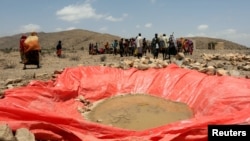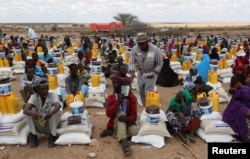Floods in Ethiopia, which come on the heels of the worst drought in 50 years, have already claimed the lives of dozens of people and displaced thousands more.
The economic toll will also be particularly severe because three-quarters of Ethiopia's population lives off the land.
The country’s economy is expected to significantly slow down in 2016, according to the IMF's World Economic Outlook forecast.
The drought, plus a decline in commodity prices, has resulted in a 4.5 percent GDP growth estimate. The figure, while above the Sub-Saharan Africa average, is a steep decline from nearly a decade of near double-digit growth in Ethiopia.
Loss of livestock, crops and households
Aid organizations anticipate continued flooding will displace about 200,000 people and affect the lives of 485,000 people.
"People can be affected in different ways. They can have damaged crops, they can lose their livestock, and in the more extreme cases lose their entire households and go quite really destitute," said Paul Handley, with the U.N.'s Office for the Coordination of Humanitarian Affairs (OCHA)’s in Ethiopia.
Roba Korji is a farmer in the central Gurage region. When the rains failed in previous planting seasons, Korji and his neighbors took out loans to build irrigation channels along a small nearby river to irrigate vegetables. Recent torrential rains and subsequent floods washed away their produce, leaving them with $18,000 in unpaid loans.
"The irrigation channels we dug led the water directly into our farms and homes. We have lost everything," Korji said.
Pastoralists also lost their livestock and homes, according to farmers in southern and central Ethiopia.
Floods compound drought crisis
The situation is exacerbated by the fact that Ethiopia has endured almost 18 months of drought, leaving 10 million people relying on humanitarian food assistance. Handley said the six affected regions had already been in a dangerous situation relating to food security.
"This is where the 10.2 million people are that we’ve been assisting already with humanitarian response but now they are also suffering with flooding. It’s really adding to the already quite dire situation," Handley said.
The government put in place a national flood task force back in March, and the country has been experiencing flooding since April.
Ethiopia has built an elaborate disaster preparedness structure to respond to communities in need, said Mitiku Kassa, who heads Ethiopia's National Disaster Risk Management Commission. The government had pre-positioned stocks for emergency response in drought- and flood-affected regions.
But Handley of OCHA said supplies are now running low. He also warned of disease outbreak because people are being forced to drink from wells that have been contaminated and surface run-off water.
"This has been quite an exceptional year in terms of weather patterns," he said. "The typical rain pattern has been quite severely disturbed. It’s about six weeks late and it’s quite intense."
The rains are causing water tables to rise and water is now flowing in some rivers that had been dry. However, the national meteorological agency anticipates a few more weeks of flooding, perhaps continuing into the summer months when the heavy summer rains occur.












